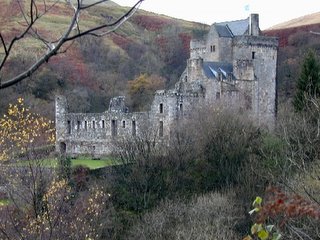 Castle Campbell: Viewed from a distance, this ancient Keep might seem to the mind of the poet,
Castle Campbell: Viewed from a distance, this ancient Keep might seem to the mind of the poet,"A palace, lifting in eternal summer
Its marble head from out a glossy bower
of leaves."
Yet a nearer acquaintance with its topography will speedily dispel this illusion. The approach to the Castle soon alters from the mild riverside way with which it begins, to the rugged and stern mountain path which terminates at the ruin.
The "bower of leaves" becomes a gloomy forest, and the "marble palace" vanishes into a grim and solitary ruin, frowning defiantly from the summit of a precipice, apparently inaccessible. The road is now narrowed to an extreme limit, and crosses the fearful chasm which partly surrounds the Castle by one of those shaky wooden bridges which terrify the soul of the timourous tourist.
The two streams, which flow around the Castle and fall into the Devon, have been named by some romantic twit in Victorian times, the Water of Care and the Burn of Greif (Gryfe). The ancient title of the ruin itself was said to be "the Castle of Gloom," and the site of the melancholy trio was "the Valley of Dolour."
This poetical combination, however, is just fanciful nonsense. Sad, but true. The name of Castle Gloom is a corruption of the Gaelic Chleum or Loch Leum, the Leap. The Water of Care is an easy transition from Caer, the prefix for a castle and its surroundings. Dollar is originally Balor, the high field.
Tradition says Castle Campbell was a portion of the dowry which Robert the Bruce bestowed upon his sister, Lady Mary Bruce, on her marriage to Neil Campbell of Lochow

No comments:
Post a Comment